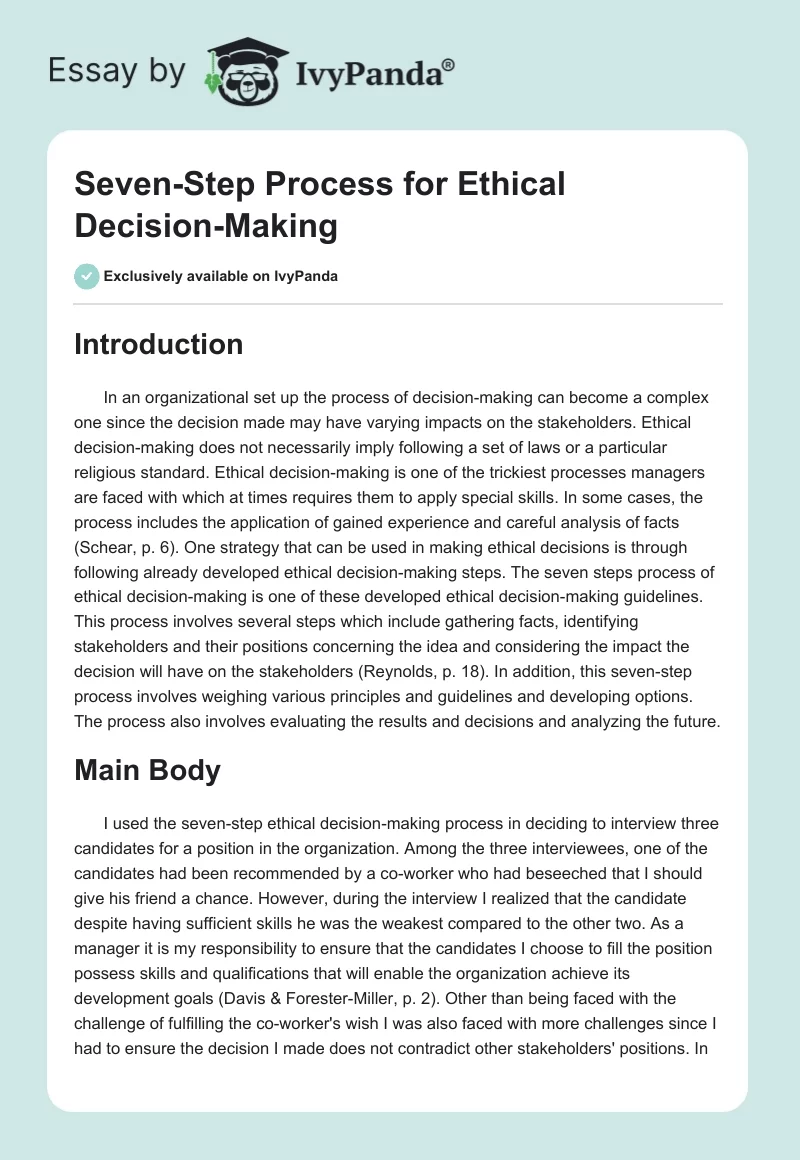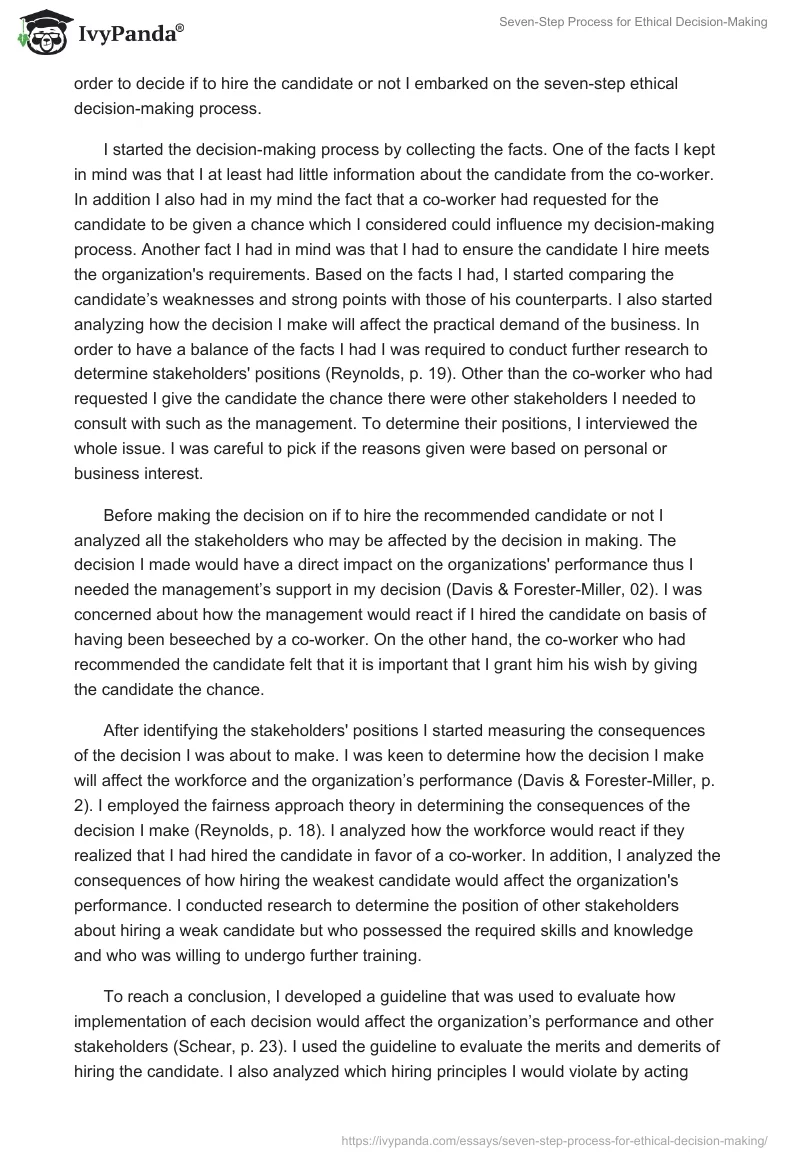Introduction
In an organizational setting, decision-making can become complex since the decision may have varying impacts on the stakeholders. Ethical decision-making does not necessarily imply following a set of laws or a particular religious standard. It is one of the trickiest processes managers are faced with, and at times, it requires them to apply special skills.
In some cases, the process includes applying gained experience and careful analysis of facts (Schear, p. 6). One strategy that can be used in making ethical decisions is following already-developed ethical decision-making steps. The seven-step process of ethical decision-making is one of these developed ethical decision-making guidelines. This process involves several steps, which include gathering facts, identifying stakeholders and their positions concerning the idea, and considering the impact the decision will have on the stakeholders (Reynolds, p. 18). In addition, this seven-step process involves weighing various principles and guidelines and developing options. The process also involves evaluating the results and decisions and analyzing the future.
Main Body
I used the seven-step ethical decision-making process in deciding to interview three candidates for a position in the organization. Among the three interviewees, one of the candidates had been recommended by a co-worker who had beseeched that I should give his friend a chance. However, during the interview I realized that the candidate despite having sufficient skills he was the weakest compared to the other two. As a manager it is my responsibility to ensure that the candidates I choose to fill the position possess skills and qualifications that will enable the organization achieve its development goals (Davis & Forester-Miller, p. 2). Other than being faced with the challenge of fulfilling the co-worker’s wish I was also faced with more challenges since I had to ensure the decision I made does not contradict other stakeholders’ positions. In order to decide if to hire the candidate or not I embarked on the seven-step ethical decision-making process.
I started the decision-making process by collecting the facts. One of the facts I kept in mind was that I at least had little information about the candidate from the co-worker. In addition I also had in my mind the fact that a co-worker had requested for the candidate to be given a chance which I considered could influence my decision-making process. Another fact I had in mind was that I had to ensure the candidate I hire meets the organization’s requirements. Based on the facts I had, I started comparing the candidate’s weaknesses and strong points with those of his counterparts. I also started analyzing how the decision I make will affect the practical demand of the business. In order to have a balance of the facts I had I was required to conduct further research to determine stakeholders’ positions (Reynolds, p. 19). Other than the co-worker who had requested I give the candidate the chance there were other stakeholders I needed to consult with such as the management. To determine their positions, I interviewed the whole issue. I was careful to pick if the reasons given were based on personal or business interest.
Before making the decision on if to hire the recommended candidate or not I analyzed all the stakeholders who may be affected by the decision in making. The decision I made would have a direct impact on the organizations’ performance thus I needed the management’s support in my decision (Davis & Forester-Miller, 02). I was concerned about how the management would react if I hired the candidate on basis of having been beseeched by a co-worker. On the other hand, the co-worker who had recommended the candidate felt that it is important that I grant him his wish by giving the candidate the chance.
After identifying the stakeholders’ positions I started measuring the consequences of the decision I was about to make. I was keen to determine how the decision I make will affect the workforce and the organization’s performance (Davis & Forester-Miller, p. 2). I employed the fairness approach theory in determining the consequences of the decision I make (Reynolds, p. 18). I analyzed how the workforce would react if they realized that I had hired the candidate in favor of a co-worker. In addition, I analyzed the consequences of how hiring the weakest candidate would affect the organization’s performance. I conducted research to determine the position of other stakeholders about hiring a weak candidate but who possessed the required skills and knowledge and who was willing to undergo further training.
To reach a conclusion, I developed a guideline that was used to evaluate how implementation of each decision would affect the organization’s performance and other stakeholders (Schear, p. 23). I used the guideline to evaluate the merits and demerits of hiring the candidate. I also analyzed which hiring principles I would violate by acting according to a co-worker’s wish (Davis & Forester-Miller, p. 2). The process involved analyzing if the candidate’s working vision would help in propelling the organization forward or not. It is from the guidelines that I realized that the main features I should look for from the candidate to fill this position include skills and knowledge which the candidate possessed.
From the information I collected from the first four steps I developed options that I needed to evaluate in order to make an ethical decision. The option was to hire the candidate since he had the potential of being trained to fill the position in the organization or hire the candidate who showed to have a strong personality in addition to having the required skills. As a process of evaluating the two options I considered other stakeholders. I realized that most of the stakeholders were positive about giving all candidates with the required skills and knowledge equal opportunity (Schear, p. 17). In addition, based on hiring principles I realized that weakness should not be a factor that should be used to disqualify a candidate since it can be improved through training. I also analyzed the two options keeping in mind I had a co-worker’s wish to fulfill. To make the decision based on the results was required to inquire from the recommended candidate if he is ready to learn and employ the skills for the benefit of the company in order to make a conclusive decision
Conclusion
From the information I collected in the seven-step ethical decision-making process I made a decision to hire the candidate not only from the basis of having been beseeched by a co-worker but also because it allowed the organization to train the candidate to its standards. However, based on the decision I made I was required to discuss the matter with other stakeholders who could have accused me of being biased in the selection and decision-making process. During the decision-making process, I helped them understand that I did not only depend on the co-worker’s recommendation but that I also conducted more research to ensure I made an ethical decision (Reynolds, p. 24).
Justification
The conclusion I made was based on the fairness theoretical approach of decision making. I did not depend on the co-worker’s recommendation but went the extra mile to evaluate other principles and options and used these in making the decision. In addition, in making the decision I ensured that all stakeholders’ wishes were not overlooked to ensure the workforce is not affected negatively (Schear, p. 12). The decision of hiring the candidate was fair and ethical since I ensured I respected all the stakeholders’ interests in making the final decision.
Works cited
- Davis, Thomas, & Forester-Miller, H. A Practitioner’s Guide to ethical decision making. US: American Counselling Association press, 1996. 1-5
- Reynolds, Walter, G. Ethics in information technology. India: Thomson press, 2007. 17-15.
- Schear, Thomas, H. Interactive ethics: How ethical and unethical decisions are really made in organizations. US: Universal publishers, 2010. 100.


